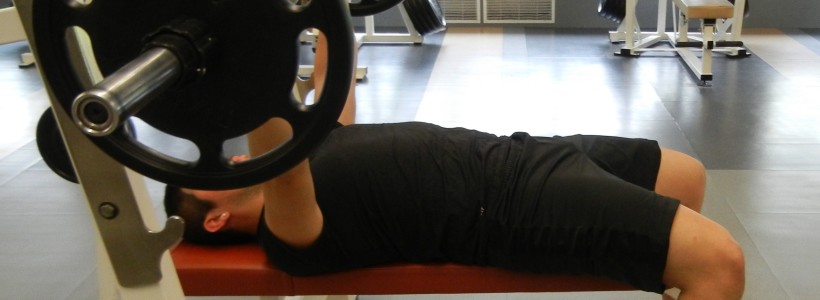Top 6 Weightlifting Mistakes #5 – The Bench Press
#5 – The Bench Press
Mistake #5 is arching your back under bench presses. When this occurs you are making the exercise easier, hurting your spine, and likely not engaging the right muscles.
While doing a bench press, or any weightlifting exercise for that matter, you should be engaging your abs. In fact, your abs should get such a good workout while doing all the exercises in your set that you should need to do very few additional core exercises.
Before you even lift the bar off the rack, you should be bracing your core. Avoid pushing your stomach muscles outward – it should feel like your belly button is moving closer to your spine, but don’t just suck in your stomach. Your stomach should look flatter than it does when you are relaxed and feel like a hard surface if pressed on.
If your back arches while lifting the bar you are likely not engaging your core, and you may be trying to lift too much weight. This is never beneficial. The purpose of doing any weightlifting exercise is for strength gains. You’ll be getting much more out of the exercise if you don’t “cheat.”
Even small maneuvers like arching your back are simply your body’s way of moving against the path of least resistance. You want to be smart and avoid these cheating maneuvers by executing the exercise in the most difficult way possible.
Lastly, arching your back a lot results in hyperextension of the low back. As I’ve discussed in detail in the series the Top 5 Exercises Firefighters Should Not Do, this is a harmful position for your spine. Firefighters are much more prone to back pain and injuries than most others, so avoid doing unnecessary actions that contribute to the problem!
Read the complete series here (posting weekly):
T0p 6 Weightlifting Mistakes
#6 – Lat Pulldown
#5 – Bench Press
#4 – Bicep Curl
#3 – Deltoid Fly
#2 – Lunges & Squats (posting 8/13/14)
#1 – Deadlift (posting 8/20/14)






….Pretty sure arching your back activates all of the pectorals, makes it harder, and makes you fight for control….where do you get your misguided information
Um… nope. I believe thats incorrect. Archingyour back just makes it more prone to hurt your spine, compared to lying flat and using your arms and chest to push forward without the assistance of your spine-friend.
Not sure which way or what kind of way you are talking about arching your back but I respectfully disagree if you mean maintaining an arch between your shoulders & butt. The Bench Press can/should be a compound lift that involves multiple muscle groups – not just the chest (Pecs) and arms (Triceps). With a proper, trained arch you can activate the back (Lats) better on the way down (like you are pulling or bending the bar back to your chest) and depending on your skill you can get the legs (Quads) involved with a push-off out of the hole (from the bottom back to the top). I’ll stress that you should be trained or work with a trainer to do this properly with strict form because you absolutely can arch too far and hurt yourself. I’ll also say that the arch must be maintained throughout the exercise, up & down through all reps – if you are arching and dropping you are 100% correct that it will lead to injury. Great series so far – looking forward to more.
I believe what Dr. Moore is writing about is over arching your back (thrusting your pelvis forward) while pushing the bar from your chest. At this point the only parts of your body that are in contact are your shoulders and your feet. This is terrible form and can be extremely harmful to your body. This happens quite often with those who have not been properly trained and/or trying to lift too much weight.
Thanks JJ for helping to address the concerns of others and clarifying. Yes, I am talking about overarching your back in this article. Andy, The lumbar spine is naturally extended so keeping a neutral spine would mean that the low back maintains a bit of a curve above the bench but we would typically not call that “arched” – mainly to avoid confusion.
I think the problem with “excessive” arching is not doing it properly and doing it with tigh hip flexors. I credit back bridges to my back health. But i learned how to do it properly.